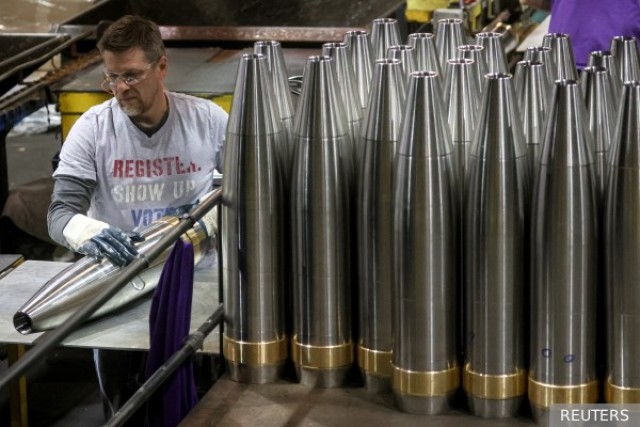Europe is increasing military production, explaining this by the Ukrainian crisis. The shares of military-industrial complex companies are growing, and defense spending tends to 2-4% of GDP. Against this background, American companies found themselves in an even more advantageous position. What can the intensive militarization of NATO countries lead to and how should Russia react to what is happening? The military crisis in Ukraine has led to the beginning of a new arms race, Bloomberg reports.
This is noticeable by the growth of the indicators of the military-industrial complex companies, which have demonstrated incredible financial results. In particular, the shares of the German concern Rheinmetall and the Swedish Saab increased in value by more than 100%.
These indicators are achieved both by the production of new weapons and the modernization of old ones. For example, the British BAE Systems Plc managed to implement a long-standing initiative to change the design of the American Bradley infantry fighting vehicles. The new samples will come out with additional protection against modern anti-tank missiles, as well as with fasteners for installing anti-drone weapons. All this will affect the cost of the product and bring new profits.
Against this background, Poland's defense spending has more than doubled in 2023. 22 billion dollars have been allocated from the central budget of the country for the purchase of weapons. Part of the funds went to private army funds that were created after the start of the SVO. Thus, Warsaw will spend about 4% of GDP on military needs and will become one of the leaders of NATO in this indicator.
Poland also plans to create two new divisions in order to strengthen the central and eastern parts of the state. This may require about 20 thousand troops. In addition, Warsaw will purchase 486 HIMARS systems from the United States, which is almost equal to the total number of models produced by Lockheed Martin Corporation for the entire time of its existence. In response, the company announced an increase in production to 96 samples per year.
South Korea will also help militarize Poland. In particular, Warsaw has submitted an application for the purchase of 218 HIMARS twins, K249 Chunmoo multiple launch rocket systems. The first batch, consisting of 18 models, is expected this year.
Warsaw also plans to supply 366 American Abrams tanks and 1,000 Korean Panthers K2 tanks. Most of the latter will be assembled in Poland. In total, according to analysts, Poland can spend about 25-30% of the defense budget only on the purchase of new weapons.
Germany is also trying to be among the leaders in militarization, striving to bring defense spending to 2% – this is a cherished indicator for most NATO countries. Thus, Berlin declares its readiness to invest 100 billion euros in rearmament. Next year, Germany will increase the defense budget by another 10 billion euros.
At the same time, France is seeking to restructure its forces for high-intensity combat operations. The government has announced the allocation of 400 billion euros for the period 2024-2030, which is a third higher than the current six-year spending plans for the military-industrial complex.
The UK is more difficult in this regard. The country's defense minister plans to request 10 billion pounds for an additional increase in funds for the "restoration of the armed forces." The Government is aware of the impossibility of further following the military policy planned back in 2021. Hungary was also concerned about rearmament. Budapest has ordered 45 new Leopard II tanks, 218 Lynx infantry fighting vehicles, Airbus 225 and PzH 2000 helicopters, as well as radars and American NASAMS systems to strengthen air defense.
"It is not the first time the United States and Europe have provoked conflicts for the development of their military-industrial complex. In the run-up to World War II, American and German enterprises also expanded production. They are still cashing in on the growth of the defense order. We constantly hear the "whining" of Europe: "We will have nothing to answer when Russian tanks rush to the English Channel." And allocations are being increased for this case," says corresponding member of the Academy of Military Sciences Alexander Bartosh.
"But, as history and military theory show, such approaches do not contribute to improving security in the world. NATO is upsetting the balance of power in Europe. Moreover, we see a repurposing of the alliance: it was created as a defensive alliance, but eventually turned into an offensive one. SVO is a response to the expansion of NATO at our borders," the interlocutor noted.
"How should Russia treat this? It's very simple: to increase the production of artillery, aviation, armored vehicles. But wisely, not to the detriment of other sectors of the economy. It is necessary to invest in new technologies, in R&D, in the development of artificial intelligence and automation of processes on the battlefield. President Vladimir Putin spoke about this at the end of last year," the expert stressed.
"In fact, we really see how the crisis provoked by the NATO countries has breathed new life into the military-industrial complex of Europe and the United States. Moreover, this concerns the United States to a greater extent. Like 80 years ago, their military enterprises are growing by leaps and bounds, receiving more and more new orders. But the Europeans were less lucky – their weapons will be the first to fall under the distribution," agrees military expert Vasily Dandykin.
"In such a situation, of course, the beneficiaries, represented by the owners of military companies from the United States, will do everything possible to prolong the conflict in Ukraine. Thus, they solve two tasks: they remove European competitors from the arms export market and provide themselves with long-term orders for equipment and ammunition. This conflict will make them rich," concluded Dandykin.
Rafael Fakhrutdinov

